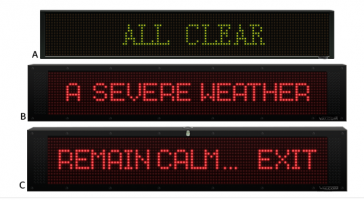Builder Bob
Sawhorse
We have a mild discussion concerning the use of a message board, speaker, and flasher for a project under construction. The question was raise about the height of installation of the sign. After receiving feedback, the viewing distance for the height of the electronic display for message sign allows for approx. 21 feet of sight distance based on the Capital Letter T.
The question: May a classroom only have one of these installed in a classroom or should two be installed to ensure that all students and teachers are within 21 feet of the sign in case of message notification. The explanation given to us from the company was that if the speaker and/or flashers went off, the person could move towards the signage.
I am not sure that meets the intent of ADA and ensuring people of disabilities can merge fluidlessly with mainstream classrooms.
Fairly neat sign - text, speaker, and flashers for notification powered off of ethernet -
allows display of date/time/ emergency situations (weather, lock down, etc.)
Not a required emergency life safety system but more of a public information message board for daily classroom operations.

The question: May a classroom only have one of these installed in a classroom or should two be installed to ensure that all students and teachers are within 21 feet of the sign in case of message notification. The explanation given to us from the company was that if the speaker and/or flashers went off, the person could move towards the signage.
I am not sure that meets the intent of ADA and ensuring people of disabilities can merge fluidlessly with mainstream classrooms.
Fairly neat sign - text, speaker, and flashers for notification powered off of ethernet -
allows display of date/time/ emergency situations (weather, lock down, etc.)
Not a required emergency life safety system but more of a public information message board for daily classroom operations.

Last edited:
